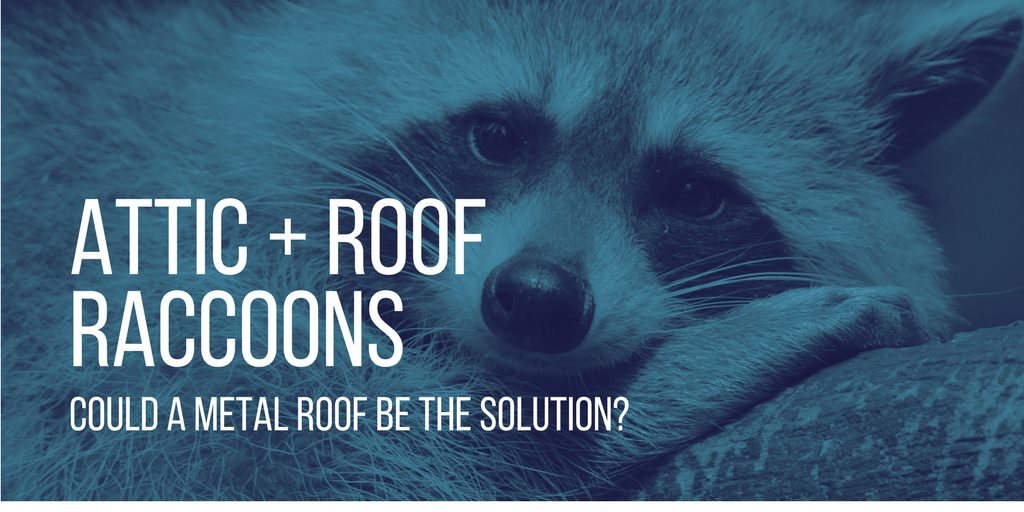Last updated on May 19th, 2017 at 06:13 pm
Every week we receive multiple calls from homeowners in Toronto and around the GTA that are losing sleep over raccoons on their roof and in their attic. Year after year, they are shelling out thousands of dollars on raccoon removal and raccoon related roof damages. Hoping for a better solution, stressed-out homeowners are increasingly exploring metal roofing as a possibly permanent raccoon deterrent. But before we can understand how a metal roof could be the solution they’ve been looking for, let’s first take a look at why raccoons love to get up on the roof and into your attic.
1. Why Do Raccoons Love to Get into My Attic?
First let’s give credit where it’s due: raccoons are very smart! With problem solving skills proven to be far greater than dogs and cats, they are also known for their exceptional mothering instincts. Female raccoons have very strong denning (nesting) instincts in the spring and your attic is the perfect place to give birth to a litter and raise her babies or “kits”.
The warmth, dryness and safety of the attic is a strong motivator for raccoons. It is common to see asphalt roofs that have been torn up by raccoons, allowing them to chew through the plywood and enter the home.
Year after year, despite your best efforts to patch up the holes and professionally clean the attic, raccoons have good memories and come back again.
2. How Do Raccoons Get Up on the Roof and Into My Attic?
Don’t be fooled by their stoutness, raccoons are exceptional acrobats. Is there a low hanging tree limb or built up porch roof next to your home? Raccoons can and will use any means to get up on your roof. In some cases, raccoons will climb up downspouts and even the corner of a brick wall. Wildlife experts have proven that much like humans, raccoons can learn through trial and error and are persistent in achieving their goals.

Examples of where raccoons can enter the attic and damage an asphalt roof. Images Source: Skedaddle Humane Wildlife Control
3. How Do I Get Rid of Raccoons Living in My Attic?
Once a raccoon family has set up a den in your attic, it will be difficult to get rid of them. Eventually Raccoons will leave on their own but not until the babies are fully developed at 8 to 9 months. There are plenty of places online listing DIY raccoon removal solutions, but you’d be well advised to use a professional wildlife control removal service. DIY raccoon removal, especially when babies are involved, rarely goes off without a hitch. Furthermore, raccoon poop can be very dangerous to humans. Raccoons can carry roundworms, an airborne parasite that can be passed on to humans. Note: Be sure to hire a professional and humane wildlife removal service NOT a pest control service – there is a big difference.

Baby Raccoon in the attic being removed by humane wildlife control service. Image Source: Skedaddle Humane Wildlife Control
How Can an Interlocking Metal Roof Help to Deter Raccoons?
We hear from many homeowners who have struggled with infestation of raccoons or other vermin and are looking for ways to better protect their home. A premium metal roof might be the deterrent that forces raccoons to search for food and shelter elsewhere. Fully interlocking panels are difficult to disengage even by human hands, and metal is much more difficult to chew-through than the paper mats of asphalt shingles. Armand Bourget who has been a metal roofing technician for over 35 years reports: “Over the 35 years that I’ve been in metal roofing there have been countless jobs where we put on an interlocking metal roof on homes with raccoon problems. I have yet to hear from anyone that needed us to come back because of raccoons.”
Wildlife control expert, Bill Dowd weighs in on the subject: “Metal roofing can be a deterrent to prevent raccoons from living in attics. With over 28 years in business, servicing over 75 municipalities throughout Ontario, Quebec and Nova Scotia, raccoons are far more likely to enter traditional shingled roofs. As with all types of roofs the most common entry area for raccoons are roof vents or ridge venting. We encourage homeowners to “raccoon proof” their homes and call a reputable company such as Skedaddle Humane Wildlife Control.”
Brampton, ON Resident John D. shares his experience in installing an interlocking aluminum roof as a raccoon deterrant:
“The installer did a great job for us and closed up and re-enforced all the openings where the raccoons were getting into the attic. Since the metal roof was put in by Classic Products Roofing, we have not had any issues with raccoons. We heard them shortly after the install trying to get back into the roof, but to no avail. It’s been several years and we have been raccoon free and couldn’t be happier…”
In Toronto, the Raccoon population explosion is well documented. Another roof tech in The Beaches reports that since his metal shingle style roof was installed in 2004, he has never seen a raccoon up on his roof. Given that he used to catch them up on his roof quite frequently, and found evidence of them defecating on his roof regularly, he reckons they moved on to other, less slippery roofs.




Leave a Reply
Want to join the discussion?Feel free to contribute!